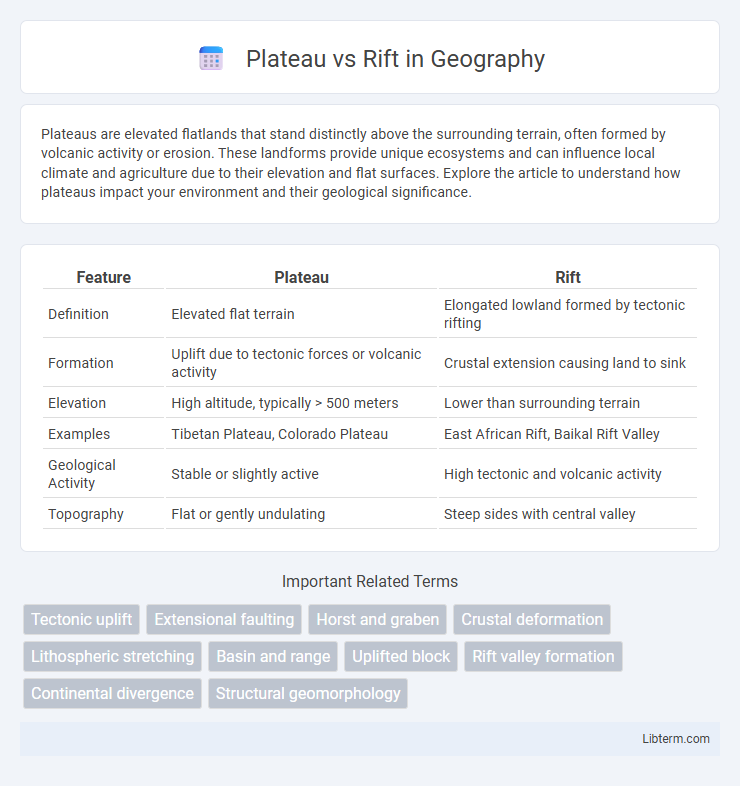Plateaus are elevated flatlands that stand distinctly above the surrounding terrain, often formed by volcanic activity or erosion. These landforms provide unique ecosystems and can influence local climate and agriculture due to their elevation and flat surfaces. Explore the article to understand how plateaus impact your environment and their geological significance.
Table of Comparison
| Feature | Plateau | Rift |
|---|---|---|
| Definition | Elevated flat terrain | Elongated lowland formed by tectonic rifting |
| Formation | Uplift due to tectonic forces or volcanic activity | Crustal extension causing land to sink |
| Elevation | High altitude, typically > 500 meters | Lower than surrounding terrain |
| Examples | Tibetan Plateau, Colorado Plateau | East African Rift, Baikal Rift Valley |
| Geological Activity | Stable or slightly active | High tectonic and volcanic activity |
| Topography | Flat or gently undulating | Steep sides with central valley |
Introduction to Plateaus and Rifts
Plateaus are elevated flatlands formed by tectonic uplift or volcanic activity, characterized by relatively stable and broad surfaces. Rifts are elongated depressions created by the divergence of tectonic plates, resulting in crustal stretching and faulting. Understanding the distinct formation processes and geological features of plateaus and rifts is essential for studying Earth's dynamic surface.
Geological Formation Processes
Plateaus form primarily through volcanic activity or the uplift of large, flat land areas caused by tectonic forces, resulting in elevated regions with relatively flat surfaces. Rifts develop from the process of continental crust pulling apart due to extensional tectonics, leading to the formation of linear valleys bordered by steep faults and often associated with volcanic activity. The contrasting geodynamic mechanisms highlight that plateaus emerge from crustal uplift or lava accumulation, while rifts originate from crustal thinning and subsidence.
Distinctive Features of Plateaus
Plateaus are elevated flat terrains characterized by relatively level surfaces that rise sharply above the surrounding landscape due to tectonic uplift or volcanic activity, distinguishing them from rifts, which are elongated depressions formed by crustal stretching and faulting. Unlike rifts, plateaus often exhibit extensive weathering and erosion patterns, and may host rich soil deposits supporting diverse ecosystems. Their stable, high-altitude environments contrast with the dynamic, subsiding nature of rifts, which commonly feature active seismic zones and fault lines.
Key Characteristics of Rifts
Rifts are elongated depressions formed by the divergent movement of tectonic plates, often characterized by active faulting, volcanic activity, and the presence of rift valleys or basins. They typically feature significant crustal thinning, high heat flow, and the development of grabens and horsts. Rifts can evolve into new ocean basins if spreading continues, as seen in the East African Rift system.
Plate Tectonics: Driving Forces
Plateaus form through the uplift of Earth's crust caused by mantle plumes or tectonic compression, elevating large, flat regions. Rifts occur where tectonic plates diverge, creating faults and subsiding land as the lithosphere thins. The driving forces behind plate tectonics include mantle convection, slab pull, and ridge push, which influence whether crustal deformation results in uplifted plateaus or extending rift valleys.
Major Examples Around the World
The Ethiopian Plateau, also known as the Ethiopian Highlands, is a prime example of a plateau formed by extensive volcanic activity and uplift. In contrast, the East African Rift Valley exemplifies a rift created by tectonic plate divergence, stretching from the Afar Triangle in Ethiopia down through Kenya and Tanzania. Other significant examples include the Tibetan Plateau, the world's highest and largest plateau, and the Baikal Rift Zone in Siberia, which hosts the world's deepest freshwater lake in a rift valley.
Ecological and Environmental Impact
Plateaus generally support diverse ecosystems with stable soil and vegetation, promoting biodiversity in arid and semi-arid regions. Rift valleys often create unique microhabitats and water-rich environments that foster endemic species but may also be prone to soil erosion and seismic activity. The contrasting geology influences water drainage patterns, with plateaus typically promoting slower runoff while rifts can accelerate sediment transport and alter local climate conditions.
Human Activity and Land Use Differences
Plateaus often support extensive agricultural activities due to their relatively flat terrain and fertile soils, enabling crop cultivation and grazing, while rift valleys typically exhibit more varied land uses influenced by volcanic soils and water availability, including intensive farming near riverbeds. Human settlements in plateaus are generally denser and more stable due to ease of construction, whereas rift regions experience dispersed settlement patterns shaped by earthquake risks and resource concentration. Mining and geothermal energy extraction are more common in rift zones, reflecting their tectonic activity and mineral deposits compared to the plateau's more uniform land use dominated by agriculture and pastoralism.
Economic Significance and Resources
Plateaus often contain rich mineral resources such as coal, iron ore, and bauxite, supporting mining industries critical to regional economies. Rift valleys, formed by tectonic plate divergence, frequently host fertile soils and abundant freshwater sources, enhancing agricultural productivity and supporting fisheries. Both landforms contribute to economic development through diverse natural resource availability and varied ecosystems.
Comparative Analysis: Plateaus vs Rifts
Plateaus exhibit elevated, flat terrains formed primarily by volcanic or tectonic uplift, whereas rifts are elongated depressions created by tectonic plates pulling apart. Plateaus often maintain structural stability and support ecosystems with consistent elevation, while rifts are characterized by intense seismic activity and the development of new ocean basins or valleys. The comparative geological processes highlight plateaus as regions of crustal thickening and rifts as zones of crustal thinning.
Plateau Infographic

 libterm.com
libterm.com